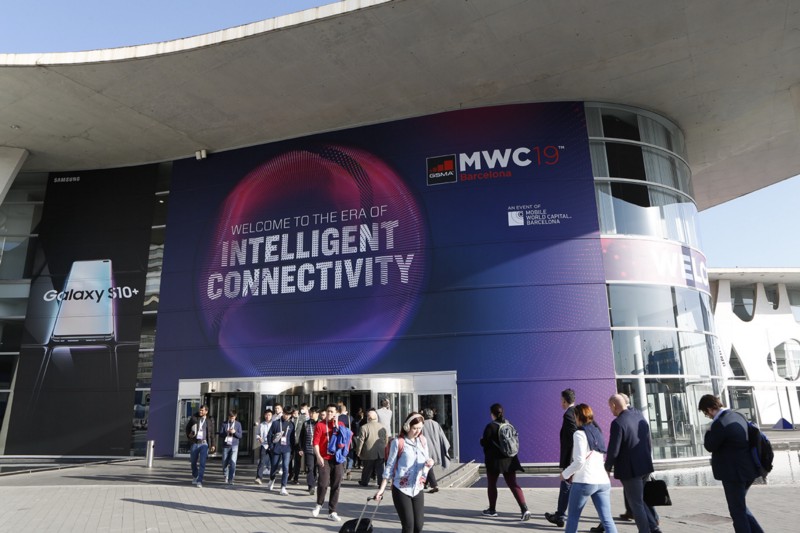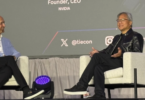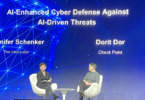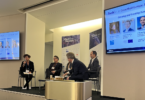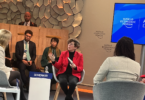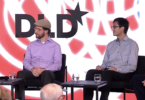MWC Barcelona 2019, which gathered over 100,000 international participants, showcased a wide range of use cases for “intelligent connectivity” including mixed reality, smart factories, robots, and autonomous vehicles.
These use cases will demand not only the rollout of fifth generation wireless networks known as 5G, which promise speeds more than 20 times faster than current 4G networks, but business models that will justify the estimated billions of euros that carriers will have to spend on this infrastructure.
New components, big advances in artificial intelligence, and new classes of devices that capture and process data, will also be required.
As a result MWC was a showcase not just of what the industry can do, but of the immense challenges and changes that lie ahead. Read on to learn about the key takeaways from this year’s conference:
5G
Momentum is growing. Last year, carriers in the U.S. and South Korea launched limited 5G network services. In 2019 a total of 16 major markets around the world are expected to have some level of commercial 5G service. As devices are developed and networks expand, 5G networks will represent 15 % of all mobile connections around the world by 2025, according to a report by the GSMA, the mobile industry’s global trade association. The rate will be much higher in China and Europe, where it will be closer to 30% of connections, and in the U.S. where 5G is expected to represent almost 50% of connections.
The same report notes that mobile operators will spend $160 billion annually on 5G upgrades. And the true cost of a 5G rollout could be much higher: A report from financing firm Greensill released at MWC says thecost of the 5G transition for things like computing infrastructure and Internet of Things implementations at industrial sites, is closer to $2.7 trillion over the next two years. “Spending on 5G roll-out is just the thin end of the wedge,” Tony Wonfor, Greensill managing director and telecoms finance specialist, says in the report.
CEOs from several major carriers expressed concerns about being able to show a clear return on their investments during a panel at MWC Barcelona. For instance, Australia’s Telstra CEO Andrew Penn, said he is worried that companies like his would shoulder the burden of financing 5G networks but other companies may make all the money providing services over those networks. He pointed out that many carriers are seeing declining returns from their current 4G investments. “How do we make sure we’re not in the same position in another 10 years?” he asked.
The technology is expected to impact not only impact the competitiveness of carriers but also of nations and regions.
The U.S., which is projected to initially lead in the number of 5G subscribers, is expected to be quickly surpassed by China, as is Europe, which has high ambitions of its own for the rollout of the technology. (See The Innovator’s 2018 cover story about 5G)
During MWC 2019 Ericsson CEO Borje Ekholm warned that the European Union’s regulatory structure was slowing adoption of 5G in the region and urged reforms or watch as Europe fell further behind the U.S. and China. “The progress in Europe is being blocked by high spectrum fees, uncertain spectrum duration and heavy regulation,” he said at a press conference by the company. “The European problem is a general investment problem and the attractiveness of investing in your network in Europe.”
China is clearly racing ahead. Huawei’s presence at MWC 2019 was closely watched given the immense backlash it has faced over the past year as the U.S. government placed enormous pressure on allies to not use the Chinese company’s hardware in 5G networks over security concerns.
The dilemma is that by many measures, Huawei is considered to have more advanced 5G technology. Indeed, at MWC 2019 the company won five awards for its technology and announced deals at MWC with carriers in countries such as South Africa, Switzerland, Bahrain, Iceland, Indonesia, Saudei Arabia and Turkey. Some European countries are, however, still considering whether to ban Huawei, as the U.S. is advising.
In a keynote, Huawei chairman Guo Ping fired back at the accusations its equipment includes backdoors for spying by the Chinese government by pointing to the Prism program used to collect data by the U.S. government (which was exposed by Edward Snowden). Ping said there is no evidence Huawei hardware allows such abuses.
“Let me say this as clearly as possible: Huawei has never built backdoors, and we will never allow anyone to do so in our equipment,” he said. “We take this responsibility very seriously.”
Edge Computing
Edge computing could hold the key to the success of high-speed intelligent connectivity. Edge computing refers to the notion that gathering and processing data happens at the source of an application or devie, or at least close to it. That is different than today’s cloud-based world, where information is hoovered up and then sent to a distant data center . Sending data at great distances create what is known in industry parlance as latency -delays in data communcations over a network. That ‘s a problem as 5G is positioned to run mission-critical applications such as autonomous vehicles, smart grids, industrial automation and remote surgeries.
SK Telecom demonstrated how it is powering smart factories in South Korea with a “Machine Vision System” and “Supernova Solutions” that blend AI, 5G, and edge computing.
China Mobile has also been making big investments in this area, creating a edge computing lab, and a new initiative aimed at creating applications for 5G in health and transformation. “Tthis has huge implications for all, making possible the creation of new applications and bringing new opportunities for a broad range of industries, from mining through to autonomous driving,” Li Zhengmao, Executive Vice President at China Mobile, said during an appearance at MWC Barcelona.
Microsoft has not had a major presence at MWC in recent years. But that changed this year with CEO Satya Nadella arriving for two days of appearances, While news reports focused on Microsoft’s launch of a HoloLens 2 augmented reality headset, an edge computing device called “Azure Kinect” , which was also announced at MWC Barcelona, could have a more profound impact.
Azure Kinect builds on technology Microsoft had previously developed for Kinect, a image-recognition device used in its Xbox gaming console. Now instead of helping people play dance party video games, the Kinect technology will link to Microsoft’s Azure cloud platform in the hopes of delivering real-time powerful image-recognition applications in places like retail stores, hospitals, and factories.
Meanwhile, Nokia demonstrated its new Open Edge Server that is designed to provide real-time computing for cloud-based virtual reality applications like gaming. Given the image density of VR, rendering the video instantly and without jitters or lags is critical for creating an experience that consumers will want, the company said. (More on immersive content below)
Finally Qualcomm president Cristiano Amon highlighted the company’s leadership in developing chips for 5G and the importance of edge computing. Amon said AI processing is now the company’s fastest-growing business. “That’s going to be the era of 5G: billions of connected things, enormous amounts of data and everyone’s going to see the need of the cloud moving to the edge,” he added.
Internet Of Things
The convergence of technologies like 5G, edge computing, and AI will power the mass adoption of Internet of Things (IoT). Beyond its speed, 5G also supports a far greater density of connections, which means networks will enable even more sensor-driven devices that are always on and always collecting data.
The GMSA report projected that global IoT connections would triple to 25 billion by 2025. It also forecast that global IoT revenue would quadruple to $1.1 trillion.
China Mobile’s Li said the company saw the number of IoT connections on its network double in 2018 to 500 million. In a keynote address, Cisco Systems CEO Chuck Robbins said the company expected there would be 4 billion machine-to-machine connections in the coming years. And beyond just the number of connections, each device connected would generate six or more times as much data as a typical device connected today.
Mobility
In recent years, connected and autonomous cars and trucks have become part of the mix at MWC. And whether one counts them as IoT devices, or in a category of their own, it’s clear that mobility is a big part of the equation for telecom companies as they push 5G networks.
At this year’s show BMW and Daimler announced a new €1 billion program to develop a platform that connects services such as as route management, booking transportation, electric car charging, parking, and ride-sharing. Eventually, this platform would hook into autonomous vehicles, the company said. Speaking at a keynote with Microsoft’s Nadella, Daimler chairman Dieter Zetsche also highlighted a recent cloud computing partnership with the company. Zetsche also talked about the massive disruption being experienced by the automotive industry as technologies like electric vehicles, autonomy, and sharing converge. “We know that 10 years from now this industry will be totally different: we’ll have some of the same competitors, and we’ll have a number of totally new competitors,” he said. “If we continue to do what we did so well, we’ll be toast.”
The Volkswagen Group announced a partnership with Cubic Telecom, which enables connected vehicles, that will use the Microsoft Connected Vehicle Platform (MCVP). And Spanish automaker SEAT announced that it is partnering with IBM Watson Machine Learning’s ‘Mobility Advisor’ on a service that can learn a user’s preferences and make personalized recommendations for how best to complete a journey. Connected to the IBM Cloud, it dynamically adapts to changing conditions by taking into account weather forecasts, traffic reports and things happening in the city that day. It incorporates the user’s appointments and historical data about previous choices in order to suggest the best modes of transportation each time – even if that means leaving the car behind, walking, or using one of SEAT’s e-Kick scooters for the part of the journey.
“With the roll-out of 5G networks in cities in the coming years, the possibilities for transforming the driver experience are limitless,” Juan Ramon Gutierrez Villar, Industry Solutions Leader, IBM Global Markets, said in a statement.
Immersive Content
If there was one big, obvious shift this year in the booths across MWC, it was the ubiquitous presence of virtual reality and cloud gaming. While VR went through a big hype phase at MWC several years ago, it fizzled as it became clear that consumers were not rushing out to buy the pricey and clunky headsets and powerful computers needed to experience this immersive technology.
But the telecom industry believes 5G changes the equation by untethering those headsets and hopefully making them a bit less clunky to wear. 5G will enables all sorts of immersive livestreaming possibilities and social interactions like VR calls or interactions with avatars. Streaming video games was perhaps the biggest application on view at MWC. Huawei, Vodafone, Qualcomm, and Nokia were just a few with such demonstrations this year.
Rather than having to buy consoles, players can stream games over their fiber-optic connections at home, which allows telecom carriers to sell subscription-based video games services much in the ways they might sell packages of TV channels.
Those services – known as cloud gaming – are now, in some cases, robust enough to also work on mobile devices over 4G networks. But with 5G, the latency goes away completely as players engage in multi-players games from anywhere. This offers tantalizing revenues carriers can build on as the rollout of 5G continues. Microsoft, Amazon, EA, Google and a host of other big names in gaming are working on their own streaming services as well.
With cloud gaming in place as a business model, 5G will allow a transition to VR services, the industry hopes. That optimism drove a frenzy of related announcements last week. Qualcomm said its chips would be used in smart glasses developed by Vuzix for enterprise customers. And Qualcomm unveiled “extended reality” viewers that mix VR and augmented reality applications for devices being developed by Xiaomi, Vivo, OnePlus, and LG.
And going one step further, Sprint announced it would partner with Hatch Entertainment to launch a mobile cloud gaming services in the U.S. on its 5G network.
The Decentralization of Everything
The decentralization of everything was a big theme at 4YFN, a sister conference focused on future technologies run by the organizers of MWC Barcelona 2019. Russian composer and blockchain investor Alexander Shulgin said he believes that within 15 years the world will be divided into seven digital unions based on culture and language, with each union or market representing roughly a billion people. HTC’s Phil Chen predicted that blockchain and cryptocurrencies will have three main impacts: New phones will allow people to control their personal data and their private keys, giving people the ability to safely store and control crypto currencies, meaning everyone could become their own bank; everyone will become a marketplace. “Today you are the product but in the future when people own their own data you will become a marketplace and be able to sell your data a la carte,” he said.; Mesh technologies will allow everyone to become a carrier and charge for services., said Chen, adding “why do [mobile services] have to be centralized?”
Jennifer L. Schenker contributed to this report.

